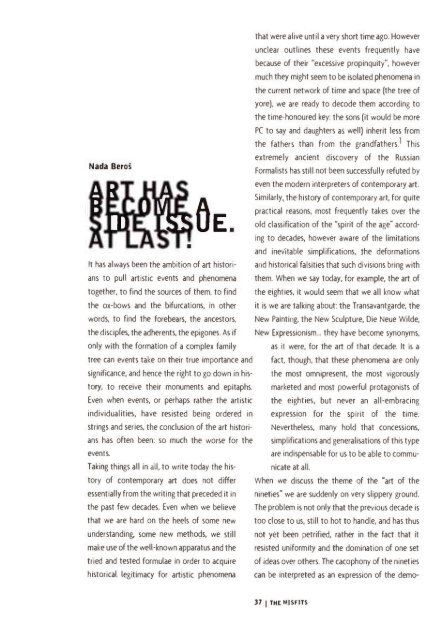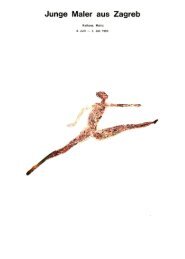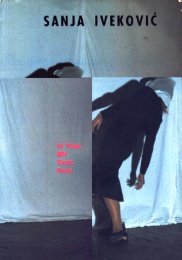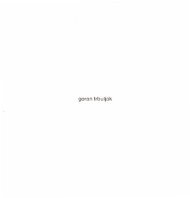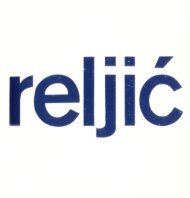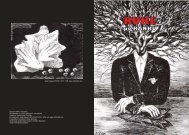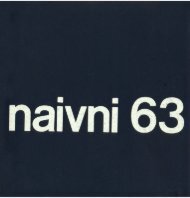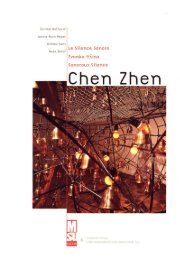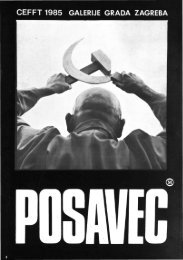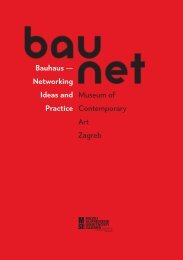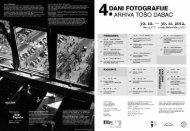The Misfits.pdf - Muzej suvremene umjetnosti Zagreb
The Misfits.pdf - Muzej suvremene umjetnosti Zagreb
The Misfits.pdf - Muzej suvremene umjetnosti Zagreb
You also want an ePaper? Increase the reach of your titles
YUMPU automatically turns print PDFs into web optimized ePapers that Google loves.
Nada Bero<br />
It has always been the ambition of art histori-<br />
ans to pull artistic events and phenomena<br />
together, to find the sources of them, to find<br />
the ox-bows and the bifurcations, in other<br />
words, to find the forebears, the ancestors,<br />
the disciples. the adherents, the epigones. As if<br />
only with the formation of a complex family<br />
tree can events take on their true importance and<br />
significance, and hence the right to go down in his-<br />
tory, to receive their monuments and epitaphs.<br />
Even when events, or perhaps rather the artistic<br />
individualities, have resisted being ordered in<br />
strings and series, the conclusion of the art histori-<br />
ans has often been: so much the worse for the<br />
events.<br />
Taking things all in all, to write today the his-<br />
tory of contemporary art does not differ<br />
essentially from the writing that preceded it in<br />
the past few decades. Even when we believe<br />
that we are hard on the heels of some new<br />
understanding, some new methods, we still<br />
make use of the well-known apparatus and the<br />
tried and tested formulae in order to acquire<br />
historical legitimacy for artistic phenomena<br />
that were alive until a very short time ago. However<br />
unclear outlines these events frequently have<br />
because of their "excessive propinquity", however<br />
much they might seem to be isolated phenomena in<br />
the current network of time and space (the tree of<br />
yore), we are ready to decode them according to<br />
the time-honoured key: the sons (it would be more<br />
PC to say and daughters as well) inherit less from<br />
the fathers than from the grandfathers.] This<br />
extremely ancient discovery of the Russian<br />
Formalists has still not been successfully refuted by<br />
even the modern interpreters of contemporary art.<br />
Similarly, the history of contemporary art, for quite<br />
practical reasons, most frequently takes over the<br />
old classification of the "spirit of the age" accord-<br />
ing to decades, however aware of the limitations<br />
and inevitable simplifications, the deformations<br />
and historical falsities that such divisions bring with<br />
them. When we say today, for example. the art of<br />
the eighties. it would seem that we all know what<br />
it is we are talking about: the Transavantgarde, the<br />
New Painting, the New Sculpture. Die Neue Wilde,<br />
New Expressionism... they have become synonyms,<br />
as it were, for the art of that decade. It is a<br />
fact, though, that these phenomena are only<br />
the most omnipresent. the most vigorously<br />
marketed and most powerful protagonists of<br />
the eighties. but never an all-embracing<br />
expression for the spirit of the time.<br />
Nevertheless, many hold that concessions.<br />
simplifications and generalisations of this type<br />
are indispensable for us to be able to commu-<br />
nicate at all.<br />
When we discuss the theme of the "art of the<br />
nineties" we are suddenly on very slippery ground.<br />
<strong>The</strong> problem is not only that the previous decade is<br />
too close to us, still to hot to handle, and has thus<br />
not yet been petrified, rather in the fact that it<br />
resisted uniformity and the domination of one set<br />
of ideas over others. <strong>The</strong> cacophony of the nineties<br />
can be interpreted as an expression of the demo-<br />
37 I THE MISFITS


